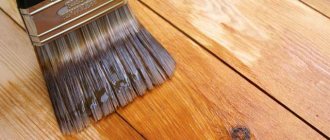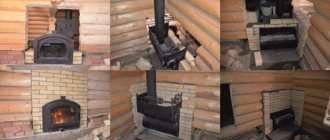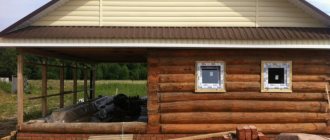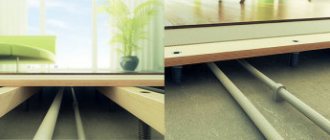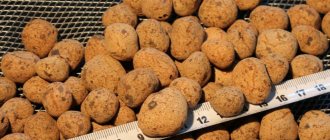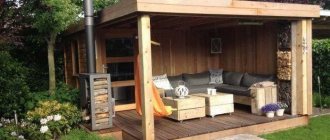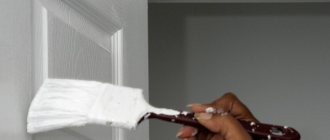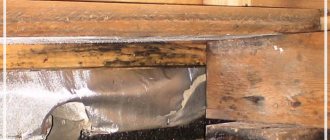Floor in the rest room
Every self-respecting owner of a country or garden plot considers it his duty to build a bathhouse. There are many reasons for this - centuries-old traditions and the desire to create a small corner of relaxation from the hustle and bustle of life. After the walls, ceiling, and roof are erected, the interior decoration of the premises is carried out. Perhaps one of the main questions in interior decoration is: how to make floors?
Any, even the smallest bathhouse, consists of several rooms. The flooring in these rooms must be suitable for their purpose. The most modest set of premises is a steam room, a relaxation room, a wash room, and an entrance hall (dressing room). The rooms differ in temperature and humidity:
- – steam room: temperature +80 – 100°C, low humidity;
- – washing room: temperature +45 – 50°C, humidity up to 100%;
- – rest room: temperature +35 – 40°C, high humidity;
- – dressing room: temperature +15 – 25°C, low humidity.
A person entering a bathhouse gradually prepares for the high temperature, moving from room to room. In the same way, the reverse transition from the high temperature of the steam room to normal ambient temperature is carried out. The result is a normal hardening effect, not stress. Let's roughly figure out what kind of floor to make in the bathhouse, depending on the room...
Types of floors in the relaxation room of the bath
There are two types of floors in the baths - concrete and wood. Concrete floors, in turn, are divided into floors on the ground and floors on the rough flooring. There are two types of wood floors - leaky and non-leaky.
Leaking wooden floors are cold floors; they are not provided with thermal insulation. They are used for the southern regions and only in bathhouses, washing rooms and steam rooms. Other types of floors are actively used in any room of the bathhouse, including rest rooms.
The designs of the above types of floor include: a base, insulated insulation and a “clean” wooden or concrete floor. However, often, especially in winter, the usual insulation of the floor in the rest room of the bathhouse is not enough. In such cases, they resort to installing various floor heating systems on their own or using the services of specialists.
Existing underfloor heating systems are divided into the following types:
- Water heated floor, which works on the principle of radiator heating;
- Warm electric floor, which has varieties according to the heating principle (convection, infrared) and the design of heating elements (cable, rod or film).
Arrangement of plywood storage space
The rules for storing plywood in an apartment and in a warehouse are the same:
- during long-term storage, sheets of material are placed in a horizontal position without packaging or tie straps;
- plywood should be laid on a previously prepared substrate (pallet) to ensure natural air circulation;
- thick wooden blocks should be laid between the layers of the stack at intervals of at least 50 cm - this will provide ventilation and prevent the sheets from sagging;
- a wooden panel should be laid on top of the stack, which will protect the plywood from dirt and mechanical damage;
- the stack should not be placed near heating devices, since drying at high temperatures leads to deformation of the material and creates a risk of fire;
- When storing plywood in an apartment, you need to regularly ventilate the room, otherwise too dry air (especially during the heating season) will lead to cracking of the material.
If the standard storage conditions are observed, even after several years the aesthetic and performance properties of plywood remain the same as on the day of purchase. But you still shouldn’t buy material “for your grandchildren,” because each brand has a certain shelf life. If FSF plywood retains all its qualities for at least 5 years, then the FC brand, which is common in everyday life, should not be used in the production of furniture and interior structures after 3 years.
Plywood is often used when an apartment is being renovated, a new house is being built and a subfloor needs to be prepared. This building material is durable and relatively inexpensive.
However, there are several important nuances that you should pay attention to when choosing and installing. Plywood for the floor should not emit harmful chemical fumes (due to glue) and should have a high degree of water resistance. Not every species can boast of this.
Water floor in the relaxation room of the bathhouse
To install a water floor in the rest room, polyethylene, steel or metal-plastic pipes are used as heating elements.
The design has a special routing along which they are laid between the base of the floor and its finishing coating. Water, antifreeze, ethylene glycol and other special solutions can be used as coolants. To reduce heat loss, heating elements are placed on a layer of heat insulation, and to increase heat transfer - on aluminum foil. Laying pipes in the floor structure is done in two ways - in the form of a spiral or a “snake”. The first method distributes heat more evenly throughout the entire underfloor heating system than the second, which has a simpler design.
Floor heating elements are not placed under the furniture of the room; this will help save money. Matte ceramic tiles, mats, slatted boards and paints and varnishes are used as a covering for a water floor.
The water floor heating system has undeniable advantages:
- Thermal energy is distributed smoothly over the entire area of the room.
- Compared to the electric type of floor, there are significant savings in energy resources.
- Internal placement of the heating system of the room.
- Low costs when heating large areas.
The disadvantages of a water floor include the difficulty of detecting the source of leaks in system elements, the need to use a water pump, and the difficulty of adjusting the temperature regime of coolants.
Leveling with plywood sheets
In old houses there are floors with worn wooden planks. If the wood is not rotten, then it should not be removed. It is enough to remove the old paint, remove debris, and level the floor with plywood sheets on top. Such multi-layer flooring will be an excellent thermal insulator. As finishing you can use laminate, linoleum, parquet boards.
Laying plywood on a wooden floor is carried out in the same way as on a screed, leaving expansion joints (gaps). Secure the sheets with self-tapping screws, twisting them so that the cap is recessed. Then they smooth everything out with a sander, filling the cracks and recesses with putty. If a parquet board is to be installed, then the underlay is covered.
Plywood should not be laid under a wooden plank floor. Natural wood is quite massive; materials from it are laid directly on the logs.
Electric floor in the relaxation room of the bathhouse
Installing an electric heated floor in the relaxation room of a bathhouse will entail additional energy costs; you need to be prepared for this in advance. Despite this, such heating systems have many advantages. Let's take a closer look at the types of electrically heated floors.
Convection floor for a relaxation room in a bathhouse
An electric convection floor is a set of heating cables laid in a certain order on a base made of a special mesh. The advantages of this heating design are the possibility of its installation under any finishing coating and automatic adjustment of temperature conditions. This system requires power supply.
Infrared film floor in the relaxation room of the bathhouse
The energy range of infrared rays is similar to solar heat.
But it does not contain ultraviolet waves, which eliminates their negative impact on visitors to the rest room. The basis of a warm film floor is a material consisting of a thin layer of carbon flexible strips securely sealed into a polymer film. To install such a system, heat-reflecting material - ISOLON or ISOVER - is laid on the prepared floor base. Film elements are placed on it, which are then covered with waterproofing polyethylene film. A finishing coating is placed on top of the system.
The advantages of infrared electric flooring over other types are:
- Possibility of laying it with heavy floor coverings such as tiles or porcelain stoneware.
- Correct installation prevents any damage.
- No harmful electromagnetic radiation.
- Parallel connection of heating elements, so the functionality of the system will not change if any of its segments breaks down.
This type of floor also has one drawback - its low moisture resistance, so this system is not suitable for the washing compartment of a bathhouse.
Infrared rod system for a relaxation room in a sauna
The core floor system consists of elements called mats.
The latter contain heating rod elements connected to the wires that supply them. All connections have a parallel connection, eliminating disruption to the functionality of the system. This system is installed in a layer of tile adhesive or in the thickness of a concrete screed. The advantages of installing an infrared rod-based floor heating system are that it does not emit electromagnetic waves and does not lose its properties due to overheating. Disadvantages of the system include dependence on electrical power and high cost.
Cable floor in the relaxation room of the bathhouse
It is necessary to prepare for the installation of a heated floor cable system. You will need the following materials:
- Materials for thermal insulation - glass wool, foamed polyethylene or cork boards;
- Special measuring equipment equipped with single or double wires;
- Metal mesh for creating cable installation guides;
- Protective fireproof foil.
Laying the system begins with placing a layer of thermal insulation on a prepared, flat and clean floor surface.
A metal mesh is laid on top, which insulates the cable from the insulation. Then guides are installed along which a proven, working cable is pulled. Any twisting or bending during installation is excluded. After placing the cable, a thermostat is connected to it. It controls the level of floor heating. The temperature sensor is placed in a corrugated tube and is located 10 cm above the surface of the future screed. This is done to easily replace the sensor in the event of a malfunction.
Then the finished system is filled with concrete screed. The question of how to cover the floor in the relaxation room of a bathhouse is not urgent here, since any finishing coating is suitable - ceramic tiles, linoleum or laminate.
The cable resistance value must correspond to its value specified in the instructions supplied with the system.
Where not to use
Despite all the advantages, plywood sheets are not recommended for use in rooms with high humidity. This is their minus. Plywood is not installed in bathhouses, swimming pools, showers, or bathrooms. Of course, there are moisture-resistant laminated varieties, but their price is high, so not everyone will want to use them over a large area.
It is not recommended to cover the floor with plywood in rooms with strong temperature changes, for example, in unheated dachas. Excessive heat after freezing may cause the sheets to warp.
Concrete floor for a relaxation room in a bathhouse
Unlike the concrete floor of the steam room or washing area, its analogue, installed in the rest room, does not require a water drainage device due to its functionality. Such a floor can be made on the ground or on a rough flooring arranged on wooden logs.
Installation of the floor on the ground in the relaxation room of the bathhouse
The floor level along the ground consists of the marks of the top point of the sand cushion, the thickness of the insulation and the concrete preparation for the finishing coating.
Such a floor does not rise higher than the base of the bathhouse building. To install a concrete floor on the ground, the bathhouse must have a strip or columnar foundation with the bottom mark of the grillage coinciding with the ground level. Installation steps:
- The work begins with removing the plant layer of soil at the site of the future floor. Then this area needs to be covered with gravel and compacted. By installing a sand cushion 30-40 cm thick, the preparation of the base will be completed. The sand needs to be leveled and compacted.
- Rolled waterproofing is spread on the finished base. This may be roofing felt or other moisture-resistant material. To create a continuous coating, the overlapping joints of the panels of material are coated with a bitumen compound. Thirty centimeters of the edge of the insulation are placed on the wall.
- Insulation is laid on top of the waterproofing. The material you can choose is polystyrene foam or mineral wool, which requires additional protection with a construction film from the moisture of liquid concrete.
- A metal reinforcing mesh with a rod diameter of 5 mm is placed on the insulation. A concrete screed 30-40 mm thick, made on a grid, completes the main process of constructing a floor on the ground. For the binder composition, fine crushed stone and a cement-sand mixture in a ratio of 1:3 are used.
Floor on rough flooring in the relaxation room of the bathhouse
The subfloor provides a ventilated underground space for drying the joists and boards, which will prevent them from rotting.
To install the floor on the flooring, logs made of timber with a cross-section of 100x200 mm are laid in increments of 50-55 cm on the isolated edges of the foundation. Skull blocks with a cross section of 150x50 mm are nailed to them from below, on which rough flooring boards 20-30 mm thick are fixed. A waterproofing material is placed on top of the subfloor, the joints of which are reliably sealed. A construction film, for example, Yutafol, is suitable for this - it is much more flexible than traditional roofing felt.
Insulation is laid on top of the insulation - mineral wool or polystyrene foam, which is covered with another layer of moisture-proof material. A reinforcing metal mesh is placed on it, which is then filled with cement-sand mortar with a layer thickness of 30-50 mm. All wooden floor elements are treated with an antiseptic solution to prevent them from rotting.
How to properly store different types and brands of plywood?
Low-grade plywood (3/4 grade) is intended for the manufacture of containers, formwork, and products without special requirements for aesthetics, so the material does not require special protection from mechanical influences. When storing elite varieties, the top sheet of the stack should be covered with a wooden shield, which will prevent damage to the outer veneer.
Grades of plywood - FK, FSF, laminated material - differ in the degree of resistance to moisture and the level of formaldehyde content. Thus, environmentally friendly FC plywood with average water resistance can be stored directly in an apartment or in any heated room. Moisture-resistant FSF plywood is characterized by a high content of formaldehyde and is used in outdoor work. Such material should not be placed in residential premises; the best option is a closed warehouse or outbuilding. Laminated plywood is covered with a special film and is highly resistant to moisture, but direct contact with water must be avoided. Storage conditions depend on the purpose of the material: laminated sheets for formwork can be folded in a barn, plywood for making furniture - in a room where the risk of mechanical damage to the protective and decorative coating is eliminated.
Covering the concrete floor in the bathhouse in the relaxation room
The best solution for finishing a concrete floor is to cover it with ceramic tiles.
It is laid on mortar or special tile adhesive, which is diluted with water. The seams between the tiles are sealed using moisture-resistant compounds. Concrete floors can be painted and covered with slatted flooring or warm coverings made from synthetic and natural materials. If the bathhouse is supposed to be used in winter, it is better to make the concrete floor in the rest room heated. The designs of such floors were described above.
Before painting the floor in the relaxation room in the bathhouse, its concrete surface is dust-free and impregnated with primers. The choice of materials for painting should be made carefully and only those intended for baths should be used. They usually consist of natural, environmentally friendly ingredients.
Proper storage of plywood
If your business is related to wood, then you know that constant work requires an impressive supply of materials that must be regularly replenished. You will also have to take care of optimal storage conditions, otherwise the plywood sheets will crack, deform, change color, rot and simply deteriorate, making it impossible to correct the current situation.
When purchasing large quantities of plywood sheets, you probably noticed that they are transported in a sealed film. It protects the goods during transportation from moisture, dirt, ultraviolet radiation, and mechanical damage. But plywood cannot be stored in this form. You will need to remove the film to expose the air, and also remove any fastening elements to avoid deformation.
Another point is related to the fact that many ordinary people do not know how to store plywood: standing or lying down? During long-term storage, the sheets must be laid horizontally. If they remain in a vertical position for a long time, they can bend and become deformed under their own weight.
General rules for storing plywood come down to the following points:
- lay the sheets on a pallet, which must be prepared in advance. In addition, the layers of the stack should be separated by thick wooden blocks to create normal air circulation;
- Once you've finished laying the plywood, cover the stack with a wooden panel. This will protect the material from dirt or damage.
Do not forget that a lot depends on the type of building material. For example, low-grade plywood, which does not have high requirements in terms of aesthetics, does not need to be covered with a wooden panel. Environmentally friendly wood can be stored right at home or in any heated room. While the product, which is intended for outdoor work, contains formaldehyde, therefore it releases toxic substances into the surrounding atmosphere. Such plywood is stored exclusively in closed warehouses or other non-residential buildings. Laminated plywood is highly resistant to moisture, but it still needs to be protected from direct contact with water during storage.
Effect of air humidity on plywood
In general, suitable conditions for plywood storage are considered to be when the temperature ranges from -40° to +50° C, and the air humidity level does not exceed 80%. Wood does not like water and dampness, but this does not mean that it should be kept near heating devices. If the air is too dry, the material will become too brittle and may crack quickly. In addition, drying at high temperatures creates a risk of fire. The best option is a dry and well-ventilated place.
If you adhere to all these conditions, the plywood will retain its properties and remain the same as on the day of purchase. But there is also no need to purchase material for the distant future. Remember that everything has a certain expiration date. For example, FSF plywood is suitable for use for 5 years from the date of production, and the FK brand begins to lose its original characteristics after 3 years.

